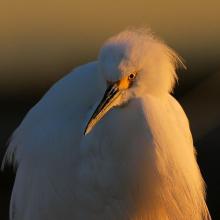

Join BirdNote tomorrow, November 30th!
Illustrator David Sibley and actor H. Jon Benjamin will face off in the bird illustration battle of the century during BirdNote's Year-end Celebration and Auction!
Today you’ll find Snowy Egrets in the south and central United States and in remnant wetlands along the Atlantic coast. But once, they were rare. During the late 1800s, millions of birds – including Snowy Egrets – were killed annually to adorn the hats of fashionable ladies. Outraged citizens took action, forming the Audubon movement and passing laws that reduced the slaughter.
Support for BirdNote comes from the Cornell Lab of Ornithology, offering online courses about birding. With a new nature journaling course at Academy.AllAboutBirds.org.
BirdNote®
Snowy Egrets – Killer Hats
Written by Chris Peterson
This is BirdNote.
[Call of the Snowy Egret, with background of Okefenokee Swamp, Georgia]
The beauty of the small, slender Snowy Egret is in its fine white feathers and long, lacy plumes. You’ll find them wading in open waters and wetlands throughout much of the United States. But once, Snowy Egrets were rare.
During the late 1800s, five million birds a year including Snowy Egrets were killed so their feathers — and sometimes even the whole birds — could be added to the hats of fashionable ladies in Europe and America. In 1886, Snowy Egret plumes were worth twice as much as gold.
[Ambient urban city, 1880s]
In a few hours during a walk through the streets of New York City, ornithologist Frank Chapman counted forty species of birds on the hats of the women he passed, including warblers, waxwings, Blue Jays, Bobwhites, and of course, Snowy Egrets.
The plundering for plumes continued until around 1910, when outraged citizens forced the passage of laws that reduced the slaughter. These are largely the same laws that protect many birds today.
“Killer hats” are now a thing of the past, and we can all appreciate the Snowy Egret in its natural habitat today.
[Call of the Snowy Egret but heavy on swamp ambient]
Support for BirdNote comes from the Cornell Lab of Ornithology, offering online courses about birding. With a new nature journaling course at academy dot all about birds dot org.
###
Producer: John Kessler
Managing Producer: Jason Saul
Editor: Ashley Ahearn
Associate Producer: Ellen Blackstone
Assistant Producer: Mark Bramhill
Narrator: Michael Stein
Nature sounds provided by The Macaulay Library of Natural Sounds at the Cornell Lab of Ornithology, Ithaca, New York. Snowy Egrets [59443-2] recorded by W.W.H. Gunn; Swamp by T. Wiewandt.
© 2019 BirdNote September 2019
ID#081905SNEGKPLU SNEG-01c
* Snowy Egret range map from Cornell’s All About Birds https://www.allaboutbirds.org/guide/Snowy_Egret/maps-range
(1) and (3) Birds of North America https://birdsoftheworld.org/bow/species/snoegr/cur/introduction
Authors K.C. Parsons and T.L. Master Price of gold 1886, Allen 1974.
(2) Permission granted to draw from the text “Killer Hats” panel 2 Historical Fashion, Killer Hats 4.0, Rev 5-12-05, v 5.5 RJB 5/31/05.
Origin of Audubon Society, Frank Chapman, waterbird protection, Lacey Act: http://birds.audubon.org/history-audubon-and-waterbird-conservation




